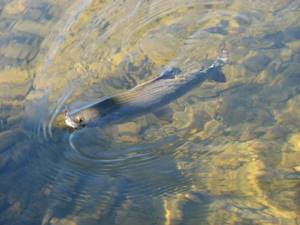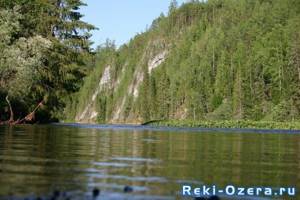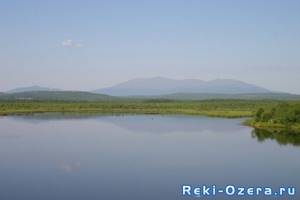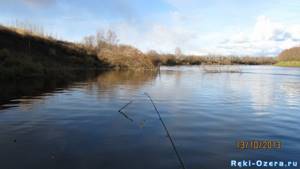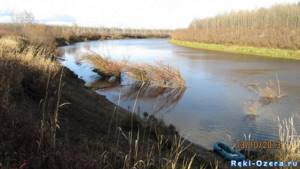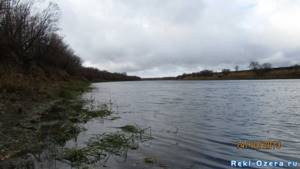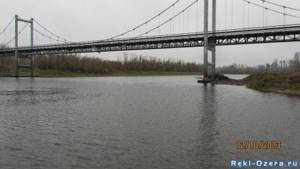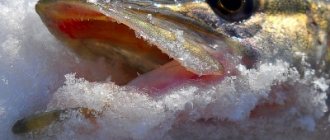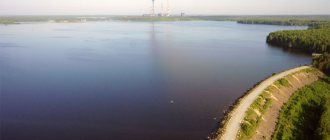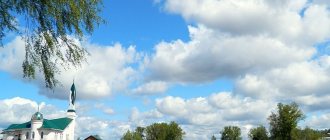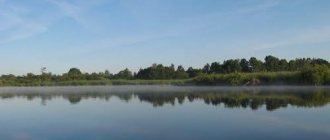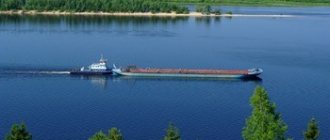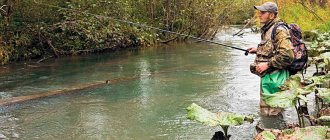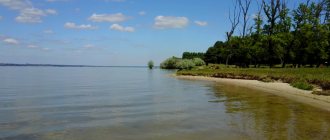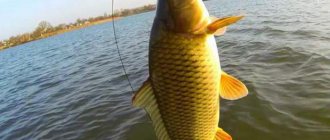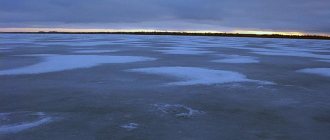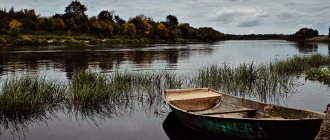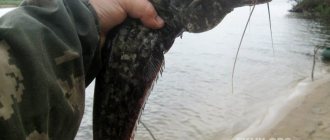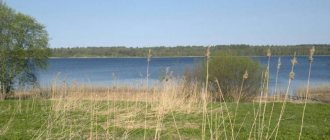deutschenglishespañolfrançaisहिन्दी
Fishing forecast > Russia > Sverdlovsk region > Sosvinsky urban district > Sosva
Find out how the fish will bite in the village of Sosva in the coming days. The bite forecast takes into account the weather, moon phase, water temperature, and seasonal fish activity.
Sosva town on the map:
Expand the map
to zoom with the mouse wheel
Move this checkbox
| February 16 Tuesday | February 17 Wednesday | February 18 Thursday | February 19 Friday | February 20 Saturday | ||||||||||||||||
| time | night 02:00 | morning 08:00 | day 14:00 | evening 20:00 | night 02:00 | morning 08:00 | day 14:00 | evening 20:00 | night 02:00 | morning 08:00 | day 14:00 | evening 20:00 | night 02:00 | morning 08:00 | day 14:00 | evening 20:00 | night 02:00 | morning 08:00 | day 14:00 | evening 20:00 |
| Weather show weather hide weather | Haze | Partly cloudy | Mainly cloudy | Mainly cloudy | Cloudy | Mainly cloudy | Mainly cloudy | Cloudy | Partly cloudy | Partly cloudy | Mainly cloudy | Supercooled fog | Supercooled fog | Supercooled fog | Mainly cloudy | Haze | Haze | Supercooled fog | Mainly cloudy | Haze |
| air temperature, °C °F feels like, °C °F | −21 -6° | −23 -9° | −18 -0° | −19 -2° | −24 -11° | −25 -13° | −19 -2° | −18 -0° | −24 -11° | −26 -15° | −22 -8° | −21 -6° | −27 -17° | −32 -26° | −26 -15° | −25 -13° | −29 -20° | −29 -20° | −21 -6° | −20 -4° |
| −28 -18° | −31 -24° | −27 -17° | −29 -20° | −33 -27° | −32 -26° | −27 -17° | −25 -13° | −31 -24° | −31 -24° | −28 -18° | −25 -13° | −29 -20° | −38 -36° | −31 -24° | −35 -31° | −36 -33° | −24 -11° | −22 -8° | ||
| water temperature, °C °F surface / depth | 1 34° / 2 36° | 1 34° / 2 36° | 1 34° / 2 36° | 1 34° / 2 36° | 1 34° / 2 36° | 1 34° / 2 36° | 1 34° / 2 36° | 1 34° / 2 36° | 1 34° / 2 36° | 1 34° / 2 36° | 1 34° / 2 36° | 1 34° / 2 36° | 1 34° / 2 36° | 1 34° / 2 36° | 1 34° / 2 36° | 1 34° / 2 36° | 1 34° / 2 36° | 1 34° / 2 36° | 1 34° / 2 36° | 1 34° / 2 36° |
| cloudiness, % | 17 | 33 | 66 | 99 | 71 | 100 | 97 | 84 | 41 | 23 | 76 | 100 | 100 | 100 | 85 | 82 | 62 | 100 | 83 | 89 |
| precipitation, mmin/6 h | 0 0 | 0 0 | 0 0 | 0 0 | 0 0 | 0 0 | 0 0 | 0 0 | 0 0 | 0 0 | 0 0 | 0 0 | 0 0 | 0 0 | 0 0 | 0 0 | 0 0 | 0 0 | 0 0 | 0 0 |
| wind | SW southwest | SW southwest | W-S-W west-southwest | W-S-W west-southwest | W-S-W west-southwest | W-S-W west-southwest | W western | W-S-W west-southwest | W-S-W west-southwest | NW northwest | SS-E north-northeast | SS-E north-northeast | E-S-E east-southeast | NNW north-northwest | NNW north-northwest | E-N-E east-northeast | South South | South South | SSW south-southwest | W-S-W west-southwest |
| wind speed, m/s km/h mph / wind gusts, m/s km/h mph | 3 / 6 11 / 22 7 / 13 wind speed 3 m/s km/h mph, gusts up to 6 m/s km/h mph wind speed 11 m/s km/h mph, gusts up to 22 m/s km/h mph wind speed 7 m/s km/h mph, gusts up to 13 m/s km/h mph Slight water disturbance. | 3 / 6 11 / 22 7 / 13 wind speed 3 m/s km/h mph, gusts up to 6 m/s km/h mph wind speed 11 m/s km/h mph, gusts up to 22 m/s km/h mph wind speed 7 m/s km/h mph, gusts up to 13 m/s km/h mph Slight water disturbance. | 4 / 5 14 / 18 9 / 11 wind speed 4 m/s km/h mph, gusts up to 5 m/s km/h mph wind speed 14 m/s km/h mph, gusts up to 18 m/s km/h mph wind speed 9 m/s km/h mph, gusts up to 11 m/s km/h mph The waters are moderately rough. | 4 / 6 14 / 22 9 / 13 wind speed 4 m/s km/h mph, gusts up to 6 m/s km/h mph wind speed 14 m/s km/h mph, gusts up to 22 m/s km/h mph wind speed 9 m/s km/h mph, gusts up to 13 m/s km/h mph The waters are moderately rough. | 3 / 6 11 / 22 7 / 13 wind speed 3 m/s km/h mph, gusts up to 6 m/s km/h mph wind speed 11 m/s km/h mph, gusts up to 22 m/s km/h mph wind speed 7 m/s km/h mph, gusts up to 13 m/s km/h mph Slight water disturbance. | 3 / 5 11 / 18 7 / 11 wind speed 3 m/s km/h mph, gusts up to 5 m/s km/h mph wind speed 11 m/s km/h mph, gusts up to 18 m/s km/h mph wind speed 7 m/s km/h mph, gusts up to 11 m/s km/h mph Slight water disturbance. | 4 / 5 14 / 18 9 / 11 wind speed 4 m/s km/h mph, gusts up to 5 m/s km/h mph wind speed 14 m/s km/h mph, gusts up to 18 m/s km/h mph wind speed 9 m/s km/h mph, gusts up to 11 m/s km/h mph The waters are moderately rough. | 3 / 5 11 / 18 7 / 11 wind speed 3 m/s km/h mph, gusts up to 5 m/s km/h mph wind speed 11 m/s km/h mph, gusts up to 18 m/s km/h mph wind speed 7 m/s km/h mph, gusts up to 11 m/s km/h mph Slight water disturbance. | 2 / 5 7 / 18 4 / 11 wind speed 2 m/s km/h mph, gusts up to 5 m/s km/h mph wind speed 7 m/s km/h mph, gusts up to 18 m/s km/h mph wind speed 4 m/s km/h mph, gusts up to 11 m/s km/h mph Slight water disturbance. | 1 / 3 4 / 11 2 / 7 wind speed 1 m/s km/h mph, gusts up to 3 m/s km/h mph wind speed 4 m/s km/h mph, gusts up to 11 m/s km/h mph wind speed 2 m/s km/h mph, gusts up to 7 m/s km/h mph Water bodies are calm. | 2 7 4 wind speed 2 m/s km/h mph wind speed 7 m/s km/h mph wind speed 4 m/s km/h mph Slight water disturbance. | 2 / 3 7 / 11 4 / 7 wind speed 2 m/s km/h mph, gusts up to 3 m/s km/h mph wind speed 7 m/s km/h mph, gusts up to 11 m/s km/h mph wind speed 4 m/s km/h mph, gusts up to 7 m/s km/h mph Slight water disturbance. | 2 / 4 7 / 14 4 / 9 wind speed 2 m/s km/h mph, gusts up to 4 m/s km/h mph wind speed 7 m/s km/h mph, gusts up to 14 m/s km/h mph wind speed 4 m/s km/h mph, gusts up to 9 m/s km/h mph Slight water disturbance. | 1 / 3 4 / 11 2 / 7 wind speed 1 m/s km/h mph, gusts up to 3 m/s km/h mph wind speed 4 m/s km/h mph, gusts up to 11 m/s km/h mph wind speed 2 m/s km/h mph, gusts up to 7 m/s km/h mph Water bodies are calm. | 1 4 2 wind speed 1 m/s km/h mph wind speed 4 m/s km/h mph wind speed 2 m/s km/h mph Water bodies are calm. | 1 4 2 wind speed 1 m/s km/h mph wind speed 4 m/s km/h mph wind speed 2 m/s km/h mph Water bodies are calm. | 1 / 3 4 / 11 2 / 7 wind speed 1 m/s km/h mph, gusts up to 3 m/s km/h mph wind speed 4 m/s km/h mph, gusts up to 11 m/s km/h mph wind speed 2 m/s km/h mph, gusts up to 7 m/s km/h mph Water bodies are calm. | 2 / 4 7 / 14 4 / 9 wind speed 2 m/s km/h mph, gusts up to 4 m/s km/h mph wind speed 7 m/s km/h mph, gusts up to 14 m/s km/h mph wind speed 4 m/s km/h mph, gusts up to 9 m/s km/h mph Slight water disturbance. | 1 4 2 wind speed 1 m/s km/h mph wind speed 4 m/s km/h mph wind speed 2 m/s km/h mph Water bodies are calm. | 1 / 2 4 / 7 2 / 4 wind speed 1 m/s km/h mph, gusts up to 2 m/s km/h mph wind speed 4 m/s km/h mph, gusts up to 7 m/s km/h mph wind speed 2 m/s km/h mph, gusts up to 4 m/s km/h mph Water bodies are calm. |
| pressure mm. Hg Art. inch Hg Art. hPa | 749 29.49 999 | 749 29.49 999 | 749 29.49 999 | 749 29.49 999 | 752 29.61 1003 | 754 29.68 1005 | 755 29.72 1007 | 755 29.72 1007 | 757 29.8 1009 | 757 29.8 1009 | 755 29.72 1007 | 754 29.68 1005 | 754 29.68 1005 | 754 29.68 1005 | 754 29.68 1005 | 754 29.68 1005 | 755 29.72 1007 | 755 29.72 1007 | 755 29.72 1007 | 755 29.72 1007 |
| humidity, % | 94 | 93 | 82 | 81 | 87 | 90 | 81 | 88 | 93 | 93 | 90 | 96 | 99 | 99 | 89 | 91 | 95 | 97 | 87 | 91 |
| Moon phase | Young Moon age: 5 days illumination: 17% distance: 403 thousand km. | Young Moon age: 5 days illumination: 25% distance: 405 thousand km. | First quarter age: 6 days illumination: 33% distance: 405 thousand km. | First quarter age: 7 days illumination: 43% distance: 405 thousand km. | First quarter age: 8 days illumination: 52% distance: 404 thousand km. | |||||||||||||||
| moonrise—moonset | 10:06—23:31 | 10:12—03:00 | 10:20—00:48 | 10:29—02:06 | 10:43—03:26 | |||||||||||||||
| sunrise—sunset | 08:28—17:55 | 08:26—17:57 | 08:23—17:59 | 08:20—18:02 | 08:18—18:04 | |||||||||||||||
| length of day | 09:27 | 09:31 | 09:36 | 09:42 | 09:46 | |||||||||||||||
| hours of sunshine per day | 5.2 | 3.5 | 3.5 | 3.7 | 3.7 | |||||||||||||||
| UV index | 1 minor UV radiation | 1 minor UV radiation | 1 minor UV radiation | 1 minor UV radiation | 1 minor UV radiation | |||||||||||||||
| fish bite 0-100% | ||||||||||||||||||||
| White amur | 0 Grass carp are not biting Grass carp are found in deep places | 0 Grass carp are not biting Grass carp are found in deep places | 0 Grass carp are not biting Grass carp are found in deep places | 0 Grass carp are not biting Grass carp are found in deep places | 0 Grass carp are not biting Grass carp are found in deep places | 0 Grass carp are not biting Grass carp are found in deep places | 0 Grass carp are not biting Grass carp are found in deep places | 0 Grass carp are not biting Grass carp are found in deep places | 0 Grass carp are not biting Grass carp are found in deep places | 0 Grass carp are not biting Grass carp are found in deep places | 0 Grass carp are not biting Grass carp are found in deep places | 0 Grass carp are not biting Grass carp are found in deep places | 0 Grass carp are not biting Grass carp are found in deep places | 0 Grass carp are not biting Grass carp are found in deep places | 0 Grass carp are not biting Grass carp are found in deep places | 0 Grass carp are not biting Grass carp are found in deep places | 0 Grass carp are not biting Grass carp are found in deep places | 0 Grass carp are not biting Grass carp are found in deep places | 0 Grass carp are not biting Grass carp are found in deep places | 0 Grass carp are not biting Grass carp are found in deep places |
| Minnow | 12 No minnow bite Minnow is found in deep places | 27 There is almost no minnow bite. The minnow is found in deep places. | 27 There is almost no minnow bite. The minnow is found in deep places. | 19 No minnow bite Minnow is found in deep places | 8 No minnow bite Minnow is found in deep places | 21 There is almost no minnow bite. The minnow is found in deep places. | 27 There is almost no minnow bite. The minnow is found in deep places. | 27 There is almost no minnow bite. The minnow is found in deep places. | 17 No minnow bite Minnow is found in deep places | 33 Sluggish minnow bite The minnow is found in deep places | 39 Sluggish minnow bite The minnow is found in deep places | 39 Sluggish minnow bite The minnow is found in deep places | 21 There is almost no minnow bite. The minnow is found in deep places. | 42 Minnow bite is worse than average Minnow is found in deep places | 35 Sluggish minnow bite The minnow is found in deep places | 35 Sluggish minnow bite The minnow is found in deep places | 18 No minnow bite Minnow is found in deep places | 35 Sluggish minnow bite The minnow is found in deep places | 35 Sluggish minnow bite The minnow is found in deep places | 35 Sluggish minnow bite The minnow is found in deep places |
| Gustera | 23 There is almost no bite for the silver bream. The silver bream is found in deep places | 30 There is almost no bite for the silver bream. The silver bream is found in deep places | 26 There is almost no bite for the silver bream. The silver bream is found in deep places. | 26 There is almost no bite for the silver bream. The silver bream is found in deep places. | 15 There is no bite for the silver bream. The silver bream is found in deep places. | 24 There is almost no bite for the silver bream. The silver bream is found in deep places. | 27 There is almost no bite for the silver bream. The silver bream is found in deep places | 38 The sluggish bite of the silver bream is in deep places | 32 The sluggish bite of the silver bream is in deep places | 37 The sluggish bite of the silver bream is in deep places | 39 The sluggish bite of the silver bream is in deep places | 46 The white bream bite is worse than average. The silver bream is found in deep places. | 34 The sluggish bite of the silver bream is in deep places | 39 The sluggish bite of the silver bream is in deep places | 34 The sluggish bite of the silver bream is in deep places | 49 The white bream bite is worse than average. The silver bream is found in deep places. | 35 The sluggish bite of the silver bream is in deep places | 39 The sluggish bite of the silver bream is in deep places | 35 The sluggish bite of the silver bream is in deep places | 49 The white bream bite is worse than average. The silver bream is found in deep places. |
| Dace | 20 There is no bite for dace. Dace is found in deep places. | 22 There is almost no bite for dace. Dace is found in deep places. | 22 There is almost no bite for dace. Dace is found in deep places. | 16 There is no bite for dace. Dace is found in deep places. | 13 There is no bite for dace. Dace is found in deep places. | 18 There is no bite for dace. Dace is found in deep places. | 23 There is almost no bite for dace. Dace is found in deep places. | 23 There is almost no bite for dace. Dace is found in deep places. | 28 There is almost no bite for dace. Dace is found in deep places. | 28 There is almost no bite for dace. Dace is found in deep places. | 33 Sluggish bite of dace Dace is found in deep places | 28 There is almost no bite for dace. Dace is found in deep places. | 29 There is almost no bite for dace. Dace is found in deep places. | 29 There is almost no bite for dace. Dace is found in deep places. | 29 There is almost no bite for dace. Dace is found in deep places. | 29 There is almost no bite for dace. Dace is found in deep places. | 30 There is almost no bite for dace. Dace is found in deep places. | 30 There is almost no bite for dace. Dace is found in deep places. | 30 There is almost no bite for dace. Dace is found in deep places. | 30 There is almost no bite for dace. Dace is found in deep places. |
| crucian carp | 0 There is no bite for crucian carp. Crucian carp is in deep places | 0 There is no bite for crucian carp. Crucian carp is in deep places | 0 There is no bite for crucian carp. Crucian carp is in deep places | 0 There is no bite for crucian carp. Crucian carp is in deep places | 0 There is no bite for crucian carp. Crucian carp is in deep places | 0 There is no bite for crucian carp. Crucian carp is in deep places | 0 There is no bite for crucian carp. Crucian carp is in deep places | 0 There is no bite for crucian carp. Crucian carp is in deep places | 0 There is no bite for crucian carp. Crucian carp is in deep places | 0 There is no bite for crucian carp. Crucian carp is in deep places | 0 There is no bite for crucian carp. Crucian carp is in deep places | 0 There is no bite for crucian carp. Crucian carp is in deep places | 0 There is no bite for crucian carp. Crucian carp is in deep places | 0 There is no bite for crucian carp. Crucian carp is in deep places | 0 There is no bite for crucian carp. Crucian carp is in deep places | 0 There is no bite for crucian carp. Crucian carp is in deep places | 0 There is no bite for crucian carp. Crucian carp is in deep places | 0 There is no bite for crucian carp. Crucian carp is in deep places | 0 There is no bite for crucian carp. Crucian carp is in deep places | 0 There is no bite for crucian carp. Crucian carp is in deep places |
| Carp | 0 No carp biting Carp are in deep places | 0 No carp biting Carp are in deep places | 0 No carp biting Carp are in deep places | 0 No carp biting Carp are in deep places | 0 No carp biting Carp are in deep places | 0 No carp biting Carp are in deep places | 0 No carp biting Carp are in deep places | 0 No carp biting Carp are in deep places | 0 No carp biting Carp are in deep places | 0 No carp biting Carp are in deep places | 0 No carp biting Carp are in deep places | 0 No carp biting Carp are in deep places | 0 No carp biting Carp are in deep places | 0 No carp biting Carp are in deep places | 0 No carp biting Carp are in deep places | 0 No carp biting Carp are in deep places | 0 No carp biting Carp are in deep places | 0 No carp biting Carp are in deep places | 0 No carp biting Carp are in deep places | 0 No carp biting Carp are in deep places |
| Bream | 30 There is almost no bream bite Bream is found in deep places | 33 Sluggish bream bite Bream is found in deep places | 33 Sluggish bream bite Bream is found in deep places | 23 There is almost no bream bite Bream is found in deep places | 19 No bream bite Bream is found in deep places | 27 There is almost no bream bite Bream is found in deep places | 34 Sluggish bream bite Bream is found in deep places | 34 Sluggish bream bite Bream is found in deep places | 41 Bream bite is worse than average Bream is found in deep places | 41 Bream bite is worse than average Bream is found in deep places | 50 Bream bite is worse than average Bream is found in deep places | 41 Bream bite is worse than average Bream is found in deep places | 44 Bream bite is worse than average Bream is found in deep places | 44 Bream bite is worse than average Bream is found in deep places | 44 Bream bite is worse than average Bream is found in deep places | 44 Bream bite is worse than average Bream is found in deep places | 44 Bream bite is worse than average Bream is found in deep places | 44 Bream bite is worse than average Bream is found in deep places | 44 Bream bite is worse than average Bream is found in deep places | 44 Bream bite is worse than average Bream is found in deep places |
| Mikizha (rainbow trout) | 24 There is almost no bite of mykiss (rainbow trout) Mykiss (rainbow trout) is found in deep places | 27 There is almost no bite of mykiss (rainbow trout) Mykiss (rainbow trout) is found in deep places | 27 There is almost no bite of mykiss (rainbow trout) Mykiss (rainbow trout) is found in deep places | 19 No mykiss (rainbow trout) biting Mykiss (rainbow trout) is found in deep places | 15 No mykiss (rainbow trout) biting Mykiss (rainbow trout) is found in deep places | 21 There is almost no bite of mykiss (rainbow trout) Mykiss (rainbow trout) is found in deep places | 27 There is almost no bite of mykiss (rainbow trout) Mykiss (rainbow trout) is found in deep places | 27 There is almost no bite of mykiss (rainbow trout) Mykiss (rainbow trout) is found in deep places | 33 Sluggish bite of mykiss (rainbow trout) Mykiss (rainbow trout) is found in deep places | 33 Sluggish bite of mykiss (rainbow trout) Mykiss (rainbow trout) is found in deep places | 39 Sluggish bite of mykiss (rainbow trout) Mykiss (rainbow trout) is found in deep places | 33 Sluggish bite of mykiss (rainbow trout) Mykiss (rainbow trout) is found in deep places | 35 Sluggish bite of mykiss (rainbow trout) Mykiss (rainbow trout) is found in deep places | 35 Sluggish bite of mykiss (rainbow trout) Mykiss (rainbow trout) is found in deep places | 35 Sluggish bite of mykiss (rainbow trout) Mykiss (rainbow trout) is found in deep places | 35 Sluggish bite of mykiss (rainbow trout) Mykiss (rainbow trout) is found in deep places | 35 Sluggish bite of mykiss (rainbow trout) Mykiss (rainbow trout) is found in deep places | 35 Sluggish bite of mykiss (rainbow trout) Mykiss (rainbow trout) is found in deep places | 35 Sluggish bite of mykiss (rainbow trout) Mykiss (rainbow trout) is found in deep places | 35 Sluggish bite of mykiss (rainbow trout) Mykiss (rainbow trout) is found in deep places |
| Burbot | 72 Good bite for burbot Burbot is located at shallow depths | 74 Good bite for burbot Burbot is found in deep places | 60 Average burbot bite Burbot is found in deep places | 52 Average burbot bite Burbot is found in deep places | 45 Burbot bite is worse than average Burbot is located at shallow depths | 59 Average burbot bite Burbot is found in deep places | 61 Good bite for burbot Burbot is found in deep places | 76 Good bite for burbot Burbot is found in deep places | 99 Excellent bite for burbot Burbot is located at shallow depths | 92 Excellent bite for burbot Burbot is found in deep places | 89 Very good bite for burbot Burbot is found in deep places | 92 Excellent bite for burbot Burbot is found in deep places | 100 The best bite for burbot Burbot is located at shallow depths | 98 Excellent bite for burbot Burbot is found in deep places | 78 Good bite for burbot Burbot is found in deep places | 98 Excellent bite for burbot Burbot is found in deep places | 100 The best bite for burbot Burbot is located at shallow depths | 99 Excellent bite for burbot Burbot is found in deep places | 79 Good bite for burbot Burbot is found in deep places | 99 Excellent bite for burbot Burbot is found in deep places |
| Perch | 0 No perch biting Perch is in deep places | 45 Perch bite is worse than average Perch is in deep places | 45 Perch bite is worse than average Perch is in deep places | 32 Sluggish perch bite Perch is in deep places | 0 No perch biting Perch is in deep places | 32 Sluggish perch bite Perch is in deep places | 37 Sluggish perch bite Perch is in deep places | 37 Sluggish perch bite Perch is in deep places | 0 No perch biting Perch is in deep places | 44 Perch bite is worse than average Perch is in deep places | 50 Perch bite is worse than average Perch is in deep places | 50 Perch bite is worse than average Perch is in deep places | 0 No perch biting Perch is in deep places | 53 Average perch bite Perch is in deep places | 53 Average perch bite Perch is in deep places | 53 Average perch bite Perch is in deep places | 0 No perch biting Perch is in deep places | 53 Average perch bite Perch is in deep places | 53 Average perch bite Perch is in deep places | 53 Average perch bite Perch is in deep places |
| Gudgeon | 10 There is no gudgeon bite. The gudgeon is found in deep places. | 27 There is almost no gudgeon bite. The gudgeon is found in deep places | 27 There is almost no gudgeon bite. The gudgeon is found in deep places | 19 There is no bite for minnows. Minnows are found in deep places. | 6 There is no bite for minnows. Minnows are found in deep places. | 22 There is almost no gudgeon bite. The gudgeon is found in deep places | 28 There is almost no gudgeon bite. The gudgeon is found in deep places | 28 There is almost no gudgeon bite. The gudgeon is found in deep places | 14 There is no bite for minnows. Minnows are found in deep places. | 34 Sluggish gudgeon bite The gudgeon is found in deep places | 40 Sluggish gudgeon bite The gudgeon is found in deep places | 34 Sluggish gudgeon bite The gudgeon is found in deep places | 14 There is no bite for minnows. Minnows are found in deep places. | 36 Sluggish gudgeon bite The gudgeon is found in deep places | 36 Sluggish gudgeon bite The gudgeon is found in deep places | 36 Sluggish gudgeon bite The gudgeon is found in deep places | 15 There is no gudgeon bite. The gudgeon is found in deep places. | 36 Sluggish gudgeon bite The gudgeon is found in deep places | 36 Sluggish gudgeon bite The gudgeon is found in deep places | 36 Sluggish gudgeon bite The gudgeon is found in deep places |
| Roach | 19 No roaches biting Roaches are in deep places | 41 Roach bite is worse than average Roach is found in deep places | 41 Roach bite is worse than average Roach is found in deep places | 29 There is almost no roach bite Roach is found in deep places | 12 No roaches biting Roaches are in deep places | 33 Sluggish biting of roaches Roaches are found in deep places | 42 Roach bite is worse than average Roach is found in deep places | 42 Roach bite is worse than average Roach is found in deep places | 26 There is almost no roach bite Roach is found in deep places | 51 Average roach bite Roaches are found in deep places | 61 Not a bad bite for roaches Roaches are found in deep places | 51 Average roach bite Roaches are found in deep places | 27 There is almost no roach bite Roach is found in deep places | 54 Average roach bite Roaches are found in deep places | 54 Average roach bite Roaches are found in deep places | 54 Average roach bite Roaches are found in deep places | 28 There is almost no roach bite Roach is found in deep places | 55 Average roach bite Roaches are found in deep places | 55 Average roach bite Roaches are found in deep places | 55 Average roach bite Roaches are found in deep places |
| Rotan | 19 There is no bite for rotan Rotan is located in deep places | 23 There is almost no bite for rotan. Rotan is found in deep places. | 23 There is almost no bite for rotan. Rotan is found in deep places. | 23 There is almost no bite for rotan. Rotan is found in deep places. | 10 There is no bite for rotan Rotan is found in deep places | 17 There is no bite for rotan Rotan is found in deep places | 19 There is no bite for rotan Rotan is located in deep places | 27 There is almost no bite for rotan. Rotan is found in deep places. | 23 There is almost no bite for rotan. Rotan is found in deep places. | 23 There is almost no bite for rotan. Rotan is found in deep places. | 26 There is almost no bite for rotan. Rotan is found in deep places. | 37 Sluggish bite of rotan Rotan is found in deep places | 27 There is almost no bite for rotan. Rotan is found in deep places. | 27 There is almost no bite for rotan. Rotan is found in deep places. | 27 There is almost no bite for rotan. Rotan is found in deep places. | 39 Sluggish bite of rotan Rotan is found in deep places | 28 There is almost no bite for rotan. Rotan is found in deep places. | 28 There is almost no bite for rotan. Rotan is found in deep places. | 28 There is almost no bite for rotan. Rotan is found in deep places. | 39 Sluggish bite of rotan Rotan is found in deep places |
| Pike | 0 No pike biting Pike are in deep places | 39 Sluggish pike bite Pike is in deep places | 31 Sluggish pike bite Pike is in deep places | 27 There is almost no pike biting Pike are in deep places | 0 No pike biting Pike are in deep places | 27 There is almost no pike biting Pike are in deep places | 25 There is almost no pike biting Pike are in deep places | 31 Sluggish pike bite Pike is in deep places | 0 No pike biting Pike are in deep places | 37 Sluggish pike bite Pike is in deep places | 34 Sluggish pike bite Pike is in deep places | 47 Pike bite is worse than average Pike is in deep places | 0 No pike biting Pike are in deep places | 50 Pike bite is worse than average Pike are in deep places | 36 Sluggish pike bite Pike is in deep places | 45 Pike bite is worse than average Pike is in deep places | 0 No pike biting Pike are in deep places | 46 Pike bite is worse than average Pike is in deep places | 37 Sluggish pike bite Pike is in deep places | 46 Pike bite is worse than average Pike is in deep places |
| Ide | 9 There are no biting ides. The ides are found in deep places. | 21 There are almost no bites for ide. The ide is found in deep places. | 19 There are no biting ides. The ides are found in deep places. | 15 There are no bites for the ide. The ide is found in deep places. | 6 There are no biting ides. The ides are found in deep places. | 17 There is no bite for the ide. The ide is found in deep places. | 19 There are no biting ides. The ides are found in deep places. | 21 There are almost no bites for ide. The ide is found in deep places. | 13 There is no bite for the ide. The ide is found in deep places. | 26 There are almost no bites for ide. The ide is found in deep places. | 28 There is almost no ide bite. The ide is found in deep places | 26 There are almost no bites for ide. The ide is found in deep places. | 14 There is no bite for the ide. The ide is found in deep places. | 27 There is almost no ide bite. The ide is found in deep places | 25 There is almost no bite for ide. The ide is found in deep places. | 27 There is almost no ide bite. The ide is found in deep places | 14 There is no bite for the ide. The ide is found in deep places. | 28 There is almost no ide bite. The ide is found in deep places | 25 There is almost no bite for ide. The ide is found in deep places. | 28 There is almost no ide bite. The ide is found in deep places |
| Ruff | 37 Sluggish bite of the ruff The ruff is found in deep places | 46 The bite of the ruff is worse than average The ruff is found in deep places | 46 The bite of the ruff is worse than average The ruff is found in deep places | 32 Sluggish biting of the ruffe The ruffe is found in deep places | 19 There is no bite for the ruff The ruff is found in deep places | 33 Sluggish bite of the ruff The ruff is found in deep places | 37 Sluggish bite of the ruff The ruff is found in deep places | 37 Sluggish bite of the ruff The ruff is found in deep places | 44 The bite of the ruff is worse than average The ruff is found in deep places | 44 The bite of the ruff is worse than average The ruff is found in deep places | 50 The bite of the ruff is worse than average The ruff is found in deep places | 50 The bite of the ruff is worse than average The ruff is found in deep places | 53 Average bite of the ruff The ruff is found in deep places | 53 Average bite of the ruff The ruff is found in deep places | 53 Average bite of the ruff The ruff is found in deep places | 53 Average bite of the ruff The ruff is found in deep places | 54 Average bite of the ruff The ruff is found in deep places | 54 Average bite of the ruff The ruff is found in deep places | 54 Average bite of the ruff The ruff is found in deep places | 54 Average bite of the ruff The ruff is found in deep places |
| Add: | ||||||||||||||||||||
How to get there
This is a navigable river. It flows through the West Siberian Plain, crossing the Khanty-Mansiysk Okrug. Its length is 754 km, and the drainage basin area is almost one hundred thousand square kilometers. The Sosva River originates in the mountains of the Ural Range, then flows into the Malaya Ob. You can get there by plane to the city of Khanty-Mansiysk, from which you will need to transfer to ground transport and head to the Berezovsky district.
There are several settlements located on Sosva - these are Igrim, Nyaksimvol and Sartynya. And at its mouth is the urban settlement of Berezovo, which has a small airfield.
Fishing on the Sosva River
- Types of fish: ruff
- perch
- Demoiselle minnow
- mustachioed Siberian loach
- gudgeon
- roach
- dace
- ide
- bream
- silver crucian carp
- tench
- pike
- Siberian grayling
- taimen
- tugun
- nelma
- burbot
Fishing
The Northern Urals are famous for their uncrowded corners. Fishing attracts residents of almost all regions of Russia. Many Ural waterways abound with rich underwater production. These are the rivers Vishera, Chusovaya, Berezovaya and, of course, Northern Sosva, which geographically belongs to the subpolar Urals. It is for this reason that its shores are still practically untouched by humans. Here the beauty of the taiga, mixed with deciduous tracts, is framed by crystal lakes and rivers with clear and very cold water. It is in the Sosva River that fish splash in large quantities. All this makes coming here a truly unforgettable adventure.
Fishing on Northern Sosva, which has long attracted lovers of quiet hunting with its natural resources, will not only be an excellent opportunity to enjoy the beauty of its shores, but also a chance to get trophy specimens of taimen, burbot, grayling or pike. This is where you can catch incredibly large fish.
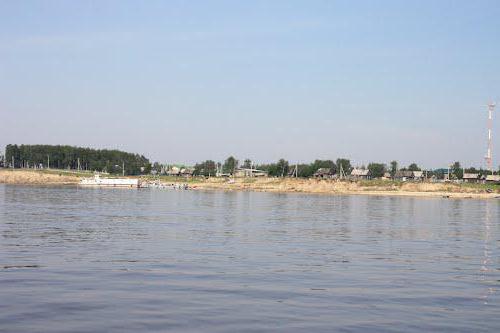
Fishing on Northern Sosva - relaxation for soul and body
Videos about us:
https://youtu.be/Tw7QIA5TCs0https://youtu.be/AOjnBQlrB7M
_
https://youtu.be/NDGFRdn2Wgghttps://youtu.be/CMH4yHkzF6Q
_
Fishing on Northern Sosva will bring the fisherman an excellent catch and become an exciting adventure. The water in lakes and rivers is clean, and a variety of fish splash in it. The reservoirs are framed by dense forests.
Fishing in this area is not just breathtaking - it is comfortable. The mobile fishing base “Breadwinner” uses modern technology when organizing fishing and offers decent living conditions and convenient routes.
Features of local fishing
In these places, fishing is not only incredibly exciting, but also comfortable. Fishing on Northern Sosva, although it takes place in subpolar conditions, however, involves the most convenient routes along which you can get to the immediate fishing spot. In addition, very comfortable conditions for living have been created here, at least those that could only be organized in the conditions of this area. And, as in almost any other region of the Urals, fishing in Northern Sosva takes place using modern technology, which greatly facilitates staying in the Subpolar conditions.
Advantages of fishing tours from “Bedkash” over “wild” fishing
Fishing tours are relaxation for body and soul. We offer fishing tours on a fire guard - a non-self-propelled vessel designed specifically for housing on the Lyapin River.
Lyapin
- a river in Russia, in the Khanty-Mansi Autonomous Okrug, the left and largest tributary of the Northern Sosva River (Ob River basin).
It is formed by the confluence of the Khulga and Shchekurya rivers, flowing from the Subpolar Urals. Length 151 km, from the source of the largest, left component - the Khulga River 404 km, basin area 27.3 thousand km². Receives the Kempazh tributary. It flows southeast along the western edge of the West Siberian Plain. Twisty. The diet is mixed, with a predominance of snow. High water from May to September. Average flow rate 345 m³/s. It freezes in October and opens in the 2nd half of May. Navigable (149 km). Those who value not only the comfort of relaxation, but also a worthy result in the form of a good catch, rely on trophy paid fishing, which has a number of advantages compared to conventional fishing:
|
- Competent organization of all stages - comfortable houses, well-thought-out routes, the best places to catch certain fish are ready for you;
- Guaranteed catch - paid reservoirs abound with fish with good marketable weight;
- Comfortable holiday in any weather and at different times of the year - depending on preferences, we organize both winter and spring, autumn and summer fishing;
- If necessary, full provision of high-quality equipment and ammunition.
To clarify the conditions for recreation and order fishing on paid reservoirs, call us back at the number or write a letter using the form on the website. Excellent trophy fishing in the north of the Urals at the Bedkash base is always profitable, comfortable and exciting!
| Insurance protection is provided by Rosgosstrakh-Ural OJSC |
Trophies
The river is rightfully considered a pantry for whitefish. Experienced hunters say that fishing on Northern Sosva has its own “specialization”. Whitefish and muksun, tugun and other representatives of the underwater world are excellently caught here. There are a lot of grayling, burbot or ide in this Ural river. But, of course, the most important treasure of this waterway is the toothy pike. Thanks to the amazingly clean nature and significant distance from nature-destructive civilization, in Northern Sosva fish weighing about five kilograms, judging by reviews, are not considered trophy. Local residents of Mansi say that pike fishing in the summer can result in a specimen three times heavier.
Some believe that nowhere else in the world there are such reserves of whitefish as in the waters of Northern Sosva. Here you can also find pyzhyan, cheese, etc. But the Sosva herring is considered the most delicious of all types of underwater inhabitants. It has a size similar to sprat, but, unlike the latter, it is very fatty and has practically no bones.
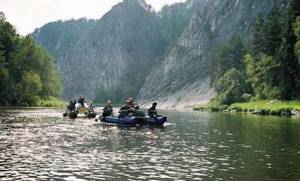
Northern Sosva is a river rich in fish
Northern Sosva is known as a “reserve” for whitefish: local waters are the habitat of whitefish. In addition, burbot is caught here; large ide is a common fish. However, the pike is rightfully considered the queen of these waters. Many fishermen caught trophy specimens on Northern Sosva. These include:
• pike weighing from three to five kilograms, in some cases up to 12 kg;
• ide weighing 1 – 1.5 kg (in some cases – more than 2 kg);
• perch weighing 0.5 kg, sometimes 1 kg;
• burbot weighing 2-3 kg, sometimes more than 5 kg.
If you are a fan of the so-called “on the doorstep” fishing, there is no better place. The boat for a small group (up to six people) is designed in such a way that at any time there is an opportunity to relax in a small cockpit, relax in a mini-sauna designed for one person, sit in the wardroom with a cup of tea, fish near the hotel on the water - To do this, just drive off on a motor boat. The captain is a commercial fisherman from Igrim. He has a lot of experience in this matter, because fishing is his favorite daily job.
For those who arrived to Northern Sosva on their own, or living on a ship is not suitable for various reasons, there is another option - to live in cozy and warm mobile buildings of the “Kedr” type. It is clear that you eat with tents in mind, and unity with nature. The tent is really good. But! What if the rains are torrential and prolonged? Nasty, will the mosquitoes prevail? Would you like cutlets with soup? What about the bathhouse? And you can’t drag too many shmurdyaks across half of Siberia - tents, sleeping bags, dishes! And the evenings and nights have been so dark since August. so long. Here you have a direct route to the branch of the fishing base “Breadwinner”. It is called “PLAN” and is located at the mouth of the river. Yalbynya at its confluence with the river. Northern Sosva at 235 km. This is 25 km below the village. Sartynya.
Amazing nature
Experienced fishermen say that the most impressive fishing on Northern Sosva is in the autumn season, when the surrounding forest is painted in bright colors, and the animals are in full swing, preparing for winter.
On the banks of the river, hares, moose, wolverines, deer, sable, mink, foxes are often found, and there is a lot of ermine here. Sometimes the “master of the taiga”—the bear—comes to the water. The undergrowth of the banks abounds in blueberries, cranberries and cloudberries, so it is not surprising that in many cases fishing on Northern Sosva smoothly turns into photo hunting.
Fishing in the Urals: features of fishing for different types of fish
The Bedkash base is located in the most picturesque place in the region - on the coast of the Northern Sosva River, in places with very clean air and amazing nature, which pleases with a huge number of plants, animals, birds and, of course, fish. Depending on the seasonality, we guarantee an excellent catch of grayling, crucian carp, char, taimen, roach, muksun, pyzhyan, and Sosva herring. Not a single expedition is complete without the queen of fishing - pike, whose weight sometimes reaches 12-15 kg.
From March 17 to 20, 2021, the Bedkash fishing base took part in the exhibition “Fishing and Hunting. Active Recreation” at the Rossiya Sports Complex (Ekaterinburg). Every year, fishing in Western Siberia is becoming more and more popular, as it harmoniously combines active recreation, excitement, the spirit of competition and a very good catch. For professionals and beginner fishermen in Yekaterinburg and the Sverdlovsk region, in Tyumen we offer weekly fishing tours thought out to the smallest detail and a comfortable stay at the base, which is ideal for bachelor and family vacations.
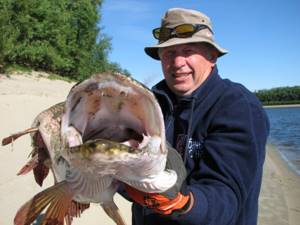
Fishing bases
Until some time, this ecologically clean, beautiful northern region was not popular among lovers of quiet hunting. But today everything has changed. Currently, almost every Russian has the opportunity to go on tour here. For this purpose, convenient modern fishing bases have been built here. On Northern Sosva, of course, there are not as many of them as, for example, on the Volga, but those that exist are practically no different from those located in the central regions of our country. These are such fishing bases as “Bedkash”, “Igrim”, “Northern Lights”, “Visiting the Goblin”, “Far”, “Deaf”, etc.
Avid fishermen who come from all over Russia stay here. Their main goal is to catch the “trophy” beauty – toothy pike. And it must be said that many people succeed in this. Specimens weighing from twelve to fifteen kilograms are found quite often in Northern Sosva. It’s rare for an expedition to come here without such trophy catches.
Almost all bases operating on the river organize tours, which include a whole package of services. These include accommodation in comfortable conditions, escort to areas where the fish are likely to bite, fishing with a fishing rod, provision of all the necessary equipment and equipment, and the presence on the vessel of an experienced captain who knows the area well.
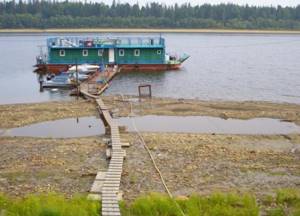
Tours
Fishing routes are designed in such a way as to be able to reach the most interesting areas for fishing with maximum savings of effort and time. The duration of the tours can be any: it changes according to prior agreement. Thus, every day an angler can choose a new water route to fish in a new, more “cool” place, without going far from the floating base. The so-called “megapike” tours are also very popular today. Their duration is seven or ten days.
Nearest populated areas:
| Green village near the station | Kiseleva village | Koshai village |
| Misha village | Rumor village | Monastyrka village |
| Novaya Zarya village near the station | Stepson village near the station | Romanovo village |
| Yakimovo village near the station |
Conditions
Those who have at least once participated in fishing on the Sosva River will return here at the first opportunity. Fishing bases are small ships designed for several people. For example, the Natalena floating base can accommodate up to eight fishermen. The ship also has a kitchen, a dining room, two cabins with TVs and DVDs, bathrooms, a bathhouse, and a large deck convenient for walking.
Almost all floating fishing bases have freezers on board in which you can store food and caught trophies. The cost of tours is three hundred and forty thousand rubles for a group of eight people. If desired, you can also order a transfer.
The Igrim base is very popular among fishermen. It has a sauna, smokehouse, and barbecue. The price includes not only accommodation in comfortable cabins, but also the use of boats, half a tank of fuel per day, meals, life jackets, echo sounder and other equipment.
Such tours are designed for seven or ten days. This period also includes the journey to the desired location. As a rule, it lasts one day. It depends on what the water level is in Sosva at the moment.
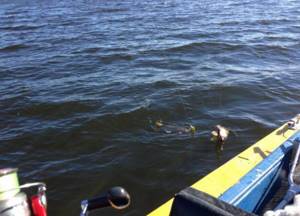
Water routes
From the right bank of the Sosva River a truly amazing view opens up, stretching for kilometers. Previously, there was a village here, which today is only reminiscent of pits.
The most popular water route begins in Saranpaul. It passes along the rivers Lyapin, Shchekurya, Yatriya, Tuyakhlanya, Sosva pier, Labytnangi station. The length of the route is four hundred and sixty kilometers. Its duration is twenty days.
The route passes mainly along the left tributaries of the Sosva, within the foothills of the eastern slope of the Urals and the hilly and ridge strip. These wild places literally abound in taimen, grayling, pike, and there are a lot of berries.
This water route itself is relatively simple: there are no difficult rapids along the way, although in the upper reaches of the Yatria there are rubble, and to Volya from Tuyakhlanya kayaks have to be dragged through taiga thickets and windfalls. Here tourists will need endurance and good orientation.
On the left bank there is a cave, the entrance to which is flooded when the water level in Sosva rises. Therefore, it is convenient to enter it on ice in winter. There are many large grottoes and beautiful limestone growths in the cave.
One of the most picturesque places along this route is Pereim, a thin rocky isthmus between Vagran and Sosva. A little lower is Shooting Stone, a picturesque rock consisting of three limestone cliffs, where the Mansi gathered to compete in archery.
Sosva River |
Sosva River |
Sosva River photo author Denis Kulpin |
Sosva River photo author Denis Kulpin |
Sosva River photo author Denis Kulpin |
Sosva River photo author Denis Kulpin |
Fishing on the Sosva River (Bolshaya Sosva): taimen, grayling, pike, perch, ide, chebak, burbot, crucian carp, tench, ruff, tugun, nelma.
Populations of taimen and grayling, for which the upper reaches of the river and its tributaries were until recently famous, have been reduced to a minimum by fishermen and poachers from nearby cities. A few individuals that are still found in the upper reaches have survived only because their habitats are inaccessible and need protection.
Only certain tributaries of the Sosva River may be of interest for fishing. Closer to the mouth, the number of large fish increases and you can quite count on large catches and trophy specimens. The famous holes in the area of the village of Romanovo and below the regional center of Sosva attract many anglers all year round.
Fishing is also interesting in the numerous oxbow lakes of the river, which are best reached in the summer by motor boat along the river itself, and then through the forest on foot. There are also forest roads to many oxbow lakes, but not all of them are passable for ordinary vehicles. In winter, the presence of a snowmobile significantly increases the chances of successful fishing, although even without such equipment, the middle and lower reaches of the river are quite actively visited by fishermen during the freeze-up period due to the presence of many “winter roads.” Catches from under the ice delight many anglers. Large specimens can be found very rarely, but standard specimens of pike, perch, burbot, ide and chebak are always present in the catches.
Direction from Yekaterinburg: Serov Distance to the nearest access point (range): 200-300 km How to get there:
1. In the upper reaches - along forest roads departing from the Severouralsk - Ivdel highway;
2. In the middle reaches - from Krasnoturinsk;
3. From Yekaterinburg to Serov 360 km, from Serov to Filkino 8 km.
Average upper/lower depths: 5-6 mm Catchment area: 24,700 km2 Sources: Eastern slope of the Northern Urals. Width in the upper/middle/lower reaches (m): 40/70/100 Average current speed (except for riffles): from 1.0 m/s in the upper reaches to 0.3 m/s near the mouth Fee: Free Comment:
In the upper reaches The Denezhkin Stone Nature Reserve is located on the river.
Description of rafting on the Sosva River in June 2010.
From the right bank of the Sosva there is an amazing view for several kilometers. The village was located on the right bank of the Sosva, below the mouth of the Kalya. Now only the swollen pits, which once served as cellars, remind of its existence.
On the left bank there is a large cave; the entrance to the cave is flooded and it is more convenient to go there in winter, when the water freezes. The grottoes in the cave are large - several meters high, and their total length probably exceeds a hundred or two meters. Attractions include beautiful limestone growths on the walls and soil of the grottoes, as well as bats. Along the right bank there are high, limestone cliffs.
The mouth of Vagran. Here is one of the most picturesque places along the route – Pereym. A thin and, at the same time, high rocky isthmus between Sosva and Vagranomt. A few more kilometers and Strelebny Stone (60°19'30''C 60°18'01''B) appears - a high (about 50 meters) picturesque rock of three limestone cliffs on the left bank below the mouth of the left tributary of the Srelebka River. There is a legend that the name came from the fact that the Mansi met here to show their art of archery. It was rare that a hunter could shoot an arrow at the top of this stone.
Sosva has such beautiful places that every rock can be safely declared a natural monument. Next is the bridge to Glukharny. We walk a few more kilometers and the Denezhkin Stone rocks (also called Samskie or Govorun) near the village of Denezhkino appear ahead. Opposite is the pioneer camp, and in front is the railway bridge across Sosva.
There are rapids ahead, but there is a lot of water in the river and the rapids do not make the proper impression. It’s another thing, at the end of summer, and huge stones stick out of the water. A long time ago, this riffle was blown up for the unhindered passage of driftwood.
The river has a clearly defined mountainous section with an abundance of rifts and beautiful coastal cliffs, which ends near the village of Maslovo.
However, anthropogenic impact does not allow the upper reaches of the Sosva to be identified as an area of interest for fishing. Geographic coordinates of the source and mouth: Source: 60°21′49.4″ N. w. 59°18′39.49″ E. Ustye village: 59°32′46.45″ n. w. 62°19′36.18″ E. Ustye village : Tavda River, 719 km from the mouth, confluence with Lozva. Coordinates: 59°32′59″ N. w. 62°20′04″ E. d. Elevation difference from mouth to source: 56-90 Settlements on the shore: Petrova, Rychkova, Gary, Pospelova, Artyushka, Makhtyli, Mishina, Sosva, Koshay, Zeleny, Rumor, Kiseleva, Sosva-nova, Romanovo, Monastyrka, Kopylova , Matushkina, Maslova, Magina, Semenova, Morozkovo, Pospelkova, Urai, Nizh. Pier, Nov. Medyankino, Filkino, Chernoyarsky, Krasny Yar, Mezhevaya, Andrianovichi, Cordon, Marsyaty, Sama, Denezhkino. Possibility of rafting: yes Minimum length of the route for rafting: 3 Maximum length of the route for rafting: 20 Routes for rafting and parking:
1. along the Serov-Ivdel railway line, which runs right along this fishing pond - choose the most suitable station and get out.
2. the Severouralsk-Ivdel highway, from which several forest roads lead to the upper reaches of the river.
3. It’s more convenient to end in the village of Marsyaty on the banks of the Sosva.
Features:
Sosva is the right tributary of the Tavda River. The Sosva River has a mixed diet, with snow predominating. The annual amplitude of level fluctuations in the middle and lower reaches is 5-6 m. The average annual water flow 140 km from the mouth is 113 m³/s, the highest is 2210 m³/s, the lowest is 4.48 m³/s. Sosva freezes in early November and opens in April. The river is used for timber rafting.
Tributaries of the Sosva: Vorobina River (4.3 km), Evalgina River (46 km), Kalinka River (95 km), Ereminka River (130 km), Pata River (141 km), Negla River (157 km), Molva River ( 167 km), Norma River (181 km), Monastyrka River (198 km), Lyalya River (Midday Lyalya) (203 km), Kurya River (237 km), Sotrina River (256 km), Pinkina River (263 km), Palkina river (273 km), Morozkova river (278 km), Prorvinskaya river (282 km), Krasnoyarka river (293 km), Tansha river (330 km), Kakva river (333 km), Mezhevaya river (346 km), river Paskotnaya (355 km), Elovka River (358 km), Turya River (372 km), Pronicheva River (382 km), Bolshaya Mezhevaya River (388 km), Chernaya River (398 km), Langur River (Northern Langur) (400 km), Bolshaya Volchanka River (405 km), Atus River (447 km), Sama River (466 km), Vagran River (501 km), Kanda River (509 km), Kalya River (Big Kalya) (517 km), Shegultan River (Big Shegultan) (537 km), Kedrovaya River (Kedrovy) (547 km), Luya River (Puya) (549 km), Mostovaya River (559 km), Sharp River (563 km), Tonga River (Little Tonga) ) (572 km), Supreya River (Bolshaya Supreya) (593 km), Kriv-Sosvinsky River (596 km), Solva River (Bolshaya Solva) (599 km), Khodovaya River (611 km), Malaya Sosva River (617 km ).
Pike fishing
In summer, besides the famous Sosva herring, the most desired catch for fishermen is “crocodile”. This is what the locals call pike. On Sosva there is a high density of this fish, because this is where its spawning ground is located. In addition, there are quite a lot of endemic pike in Northern Sosva. In the fall, huge herds of this predatory fish move here, rushing for their favorite food - whitefish. Therefore, as reviews indicate, during this season the concentration of pike in the river reaches unprecedented levels.
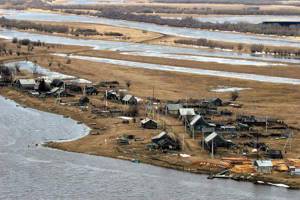
If catching this fish on the neighboring, larger Ob River involves trophy specimens weighing from ten to fifteen kilograms, then on Northern Sosva this count starts from twenty kilograms.
Fishing on the Irtysh
The current of this river is considered to be quite calm, so it is not recommended to use massive baits. The Irtysh is a wide river, and it is convenient to travel along it by boat. A large number of sturgeon live here: sterlet, Siberian sturgeon, and the river is also rich in salmon and carp species. As reviews indicate, almost any tackle can be used on the Irtysh.
In the Irtysh, perch fishing is excellent along almost the entire length of the river. You can also enrich yourself with pike perch, which is caught here at dawn or after sunset. You can start hunting with a worm. If it doesn’t bite well, then you need to switch to live bait. This increases the chance of catching predatory fish.
The following can be used as bait:
- Porridge.
- Dough.
- Peas.
- Wheat.
- Legumes.
Tackle
From the beginning of June, large pike begin to feed on bream and crucian carp. At this time, it can mainly be found in shallow water or in oxbow lakes, where the water is warm. If the water level in Sosva has not yet subsided, then large pike go into the flooded coastal willows. At this time, the most catchy baits are surface and near-surface species. In the first two summer months, pike are amazingly greedy and aggressive, so anglers boldly use gliders, propbaits and megapoppers.
When fishing for this fish, the most popular tackle is spinning. Firstly, this fishing method adds interest and spice to fishing, and secondly, it increases the chance of catching trophy specimens. However, fishing with a rod is no less common and is considered no less successful.
Lures
As a rule, when using a spinning rod, appropriate attachments are selected for it - wobblers, rubber fish, twisters. Many people, of course, also practice fishing with live bait. Using a spinning rod in Sosva, it is convenient to catch pike in algae thickets, where it often hides, lying in wait for prey.
For large fish, it is better to use spiral winding carabiners, as well as monofilament with a dough from thirty to fifty kilograms. The most optimal ones on Sosva are spinner spoons weighing from 35 to 45 grams, as well as jig heads with a similar weight and multi-colored rubber wobblers with a length of ten to twenty centimeters.
What is the Ob rich in?
The Ob is considered one of the largest rivers in the world . Its deep currents abound with a variety of fish, and islands of sand are replaced by dense vegetation.
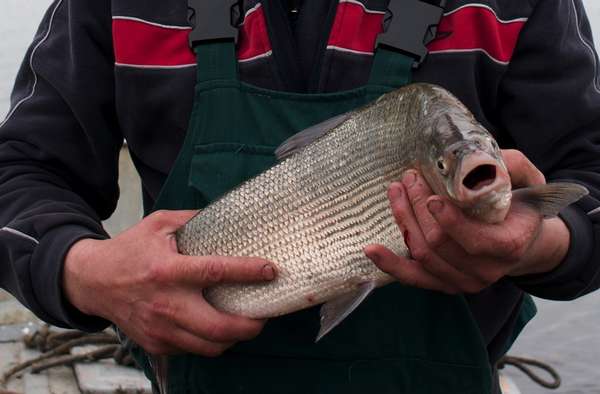
Local residents joke that if you scoop a bucket into the river, you will get a bucket of perch instead of water. But the diversity of the Ob does not end with perches; pike, sturgeon, pike perch, burbot, crucian carp and many other species are also found here. The total number exceeds 50 items. But the most popular fish here are burbot, muksun and sterlet.
Theme of poaching
There is nothing to do on the Ob River without special permission. For catching Siberian sturgeon, which is famous for its caviar, you can get a fine of up to 1 million rubles or a summons to court. Thanks to such measures, there are much fewer poachers in Siberia. But fishing here is still possible if you buy a license to catch other fish, for example, sterlet or nelma. Near the villages you can fish for pike and perch.
Fishing technique
Experienced fishermen advise fishing from the shore using a spinning rod, and for large fish using the trolling method. For effective fishing, you need to have fishing equipment, which includes a boat, a powerful spinning rod with a spoon, and high-quality bait.
Trolling will help you catch big trophy fish, so you need to prepare carefully for it.
Catching pike and perch
Although pike is not a rare species, and you can catch it in almost any body of water, here it can be of enormous size - up to 10 kg, and sometimes more.
You can catch pike with almost any gear . The main thing is to choose the right place and have a little dexterity. You also need to remember some rules:
- To properly hunt pike, you need to figure out how the predator will be caught. There are passive and active methods: with passive methods, these are girders, with active methods, spinning rods and a track.
- If you choose the first option, i.e. girders, then it is better to swim on a boat and catch pike in bays and estuaries. Moreover, it is necessary to catch small fish in advance as bait for pike and only then go to catch the predator.
- If the choice fell on stationary girders, then it is better to catch pike in thickets and snags.
- If you choose a spinning rod as the main tool, then you need to fish in places with a clean bottom, for example, on some stretch of the Ob River.
- Pike is an unpretentious fish, so any bait, such as a spoon or twister, will do.
- Instead of fishing line when fishing for pike, it is better to use braid and a steel leash.
Perch, like pike, is a very common fish that lives in almost all bodies of water, except mountain rivers and reservoirs with very cold water. The Ob River is home to regular-sized perch. To catch a larger predator, you need to understand its preferences. It lives in deep-sea pools, just below dams and rapids, as well as at river bends. You can more accurately determine its location by finding out where its food accumulates.
It is better to catch perch on a medium-hard rod, and use poppers, spinners or cicadas as bait. The choice of fishing line is not important - both braided and monofilament will do .
Carp, carp and pike perch
In summer, carp and carp are excellently caught in the Ob. As with catching other fish, the first step is to choose the right fishing spot. The main thing you should know is that these fish like to live in quieter places, unlike predatory fish. Among such places there are deep holes, rubble of stones and trees, and other places with weak currents.
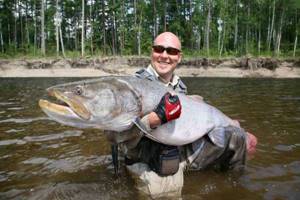
It is better to go out for carp early in the morning or in the evening. You can easily determine its habitat by the characteristic splash of water. The main thing when fishing for carp is to maintain silence and choose gear that does not make unnecessary movements. Anything can be used as bait: from any cereals to special baits for fish. A handful of worms are used as bait .
When choosing a fishing line, you should pay attention to its length. You need to select a medium-length option so that the massiveness of the device does not scare away the carp during the bite. When fishing with a float rod, the line should not be more than 2 times longer than the rod. Otherwise, the fish will simply tear it off; even a strong fishing line will not help.
The pike perch on this river is impressive in size. While in other bodies of water you can catch specimens weighing 1-2 kg, here you can find specimens weighing up to 6 kg.
It is recommended to catch pike perch in the area of the village of Pervomaiskoe using a spinning rod . You should travel by boat.
Best season
The best time for fishing is spring. It is after spawning, when the predator begins to eat, that the most successful pike fishing in this river takes place. At this time, prey can be caught using absolutely any bait. And after Zhora, already in late spring, cloudy warm days are especially catchy, when fishing with a rod brings excellent results.
It is known that the pike bite is irregular in summer, but it is quite possible to catch one. Northern Sosva is amazing in this regard, because even in June there is a high and stable catch, although less abundant compared to autumn.
Come July, anglers move from the tributaries to the main river as water levels begin to recede. Fish, which is the main food for pike, begins to migrate from tributaries and oxbow lakes, preparing for winter. And just at this time, the pike takes a position in the pits, which are located next to the exits of their food base.
At this time, there are so many predators that they create a kind of “carousel”: some, having eaten, go into the depths, while others come to take their place. Thus, this process becomes continuous.
Judging by the reviews, fishing excitement often disappears on Sosva during this summer period, since there are so many predators in such places that every cast is a catch.
Waiting for the autumn zhora on Sosva
09/16/2016 admin
September is a “hot” time on northern reservoirs. There are almost no mosquitoes and midges, fish activity is increasing every day, and hunting enthusiasts are happy to be distracted from fishing for duck and upland game that has gained fat. There are clearings of ripe berries all around and a bunch of magnificent, vigorous mushrooms underfoot. All this is wonderful, but what to do if there are still a couple of weeks left before this blessed time, and it is no longer possible to restrain the fishing itch. There is only one recipe - run to the river.
We had a serious fishing trip planned for the end of September. An interesting route, excellent fishing prospects - all this was ahead, and all participants in the upcoming trip were looking forward to “Day X”. All the more unexpected was the proposal of old comrade Victor, also a participant in the planned trip, to while away the tense wait on a short fishing tour. Four or five days on the pond and a couple on the road - we had to finish it just in time for the start of the next working week. Victor is an experienced fisherman, a reliable friend, the “soul” of the company and, importantly, has at his disposal various watercraft and huts along the banks of different rivers. Such offers are not refused. Try to “grab the fishing gear after departure, nothing will be forgotten or lost, not a single trifle of camp life can hide from his economic gaze. So, without saying a word, we once again arrived at our usual river “table of ranks.” During fishing, everyone is equal, but in the parking lot I supervise the catering department, Andrey “rustles” about the housework (tent, table, kettles, fire pit, firewood, etc.), Victor is responsible for the boat, engine, chainsaw and other technical issues.
There are no questions about everyday life and travel logistics, but how will the river please us? Fishing in the first ten days of September, strange as it may sound, is much less predictable than in June - July. I myself, following stereotypes quite a number of times, lost a lot of precious time understanding that fishing in early autumn with baits “promoted” in magazines and in places thoroughly described by experienced fishermen does not at all guarantee record catches. On a variety of trips, we were repeatedly convinced that the top-end wobblers, spinners and rubber, which worked flawlessly on a reservoir for a couple of seasons in a row, can suddenly find themselves out of work in the same place. On the upcoming trip, all this did not bother us much, since we were confident that with our “relaxing” fishing plan we would get maximum pleasure from the trip in any case.
Fishing began quite slowly on the main river not far from Khulimsunt. Vitya knew these places thoroughly. It seemed that we acted for sure, but the high water level made its own adjustments. Moving downstream Sosva Steep yars and bushes flooded in shallow water, holes and sand spits, the mouths of flowing streams and rivulets - nothing escaped our attention. Using various baits, we tried to provoke the passive, as we already understood, predator to bite. No matter what we did and how we didn’t get rid of ourselves. Passages up and downstream “on a motor” with various wobblers alternated with careful fishing with “hardware” and “rubber” of the hottest, in our opinion, places. Even isolated attempts to seduce the predator with live bait led to nothing. The entire first day on the water was spent understanding that the predator had to be looked for elsewhere. A few medium-sized perches and a couple of small pike - this is the result of a very hard day on the main river.
The rain that began to fall in the evening, sometimes turning into a decent downpour, made us completely forget about fishing and retire to one of Victor’s huts, awaiting mercy from the weather. From the fish caught in the pouring rain, they prepared an excellent fish soup, which not only had a beneficial effect on stomachs rumbling from hunger, but also instilled a certain optimism and hope for the next day.
As if as a reward for our patience and perseverance, the morning greeted us with a cloudless sky and the cheerful chirping of birds, which, like us, were quickly recovering from a hard, rainy night. We started fishing again in a great mood. In the bright sunlight, the abandoned villages on the steep banks of Sosva no longer seemed to us like classic settings for horror films, and the river whirlpools and whirlpools were no longer perceived as gloomy as the day before. The weather improved, but the predator continued to go on strike. All morning optimism disappeared after 5-6 hours of intense fishing. Excellent places, the most proven and killer baits brought only single bites of small squints, perches and roaches. By lunchtime on the second day, it became absolutely clear that further fishing in this mode was doomed to complete failure. In the muddy water of the main river, there were either no pike and perch, or they categorically refused to take them. Outside it’s 25°C, the water in the river is the color of “coffee with milk” in some places. What to do? An eternal question, including for fishermen, in Rus'...
Knowing that large toothy predators and humpback perch were somewhere nearby and in considerable numbers, we understood that we were doing something wrong. We decided to completely change all the main components of fishing - fishing spots, search methods. We also decided not to use new expensive “glamorous” baits purchased over the winter when searching for fish. They decided to focus all their attention on the repeatedly tested “search engines”. Without further ado, the Manns “rubber”, the trouble-free Blue Fox spinner No. 3 and the fast ZIP BAITS Rigge 7 cm long took their rightful places on the carabiners of the three rods.
In the remaining days, they decided to look for fishing luck in deep streams and tributaries, in which it was possible to climb at least a couple of kilometers. And even though most of them originate from swamps, during this period their cleanliness and coolness turned out to be incomparably better than the main river. Usually, it is, of course, completely impossible to enter most of them and move up at the beginning of September, but the “high water” factor played into our hands. The rains, which turned the main river into a muddy stream, provided the opportunity to visit several previously inaccessible tributaries of the Sosva, where the water had already risen, fixed at a certain level and significantly cleared.
The very first entry into the mouth of the nearest relatively small stream and an ascent of only 100 m immediately brought the first full-sized trophies - five large perches and a couple of marketable pike. Several more predators quickly ran away from the boat as we approached. Already something. It was possible, of course, to try to climb further along the stream in search of promising places, but small pre-estuary rapids and dense coastal windfall immediately discouraged such a desire even from the most zealous extreme sportsmen. The slightly deeper second stream rewarded our team with a pair of “toothy” ones weighing 2 kg, a dozen qualifying “humpback whales” and three plump ides.
The trend is clear; before dark, we decided to enter at maximum speed into a relatively large nearby tributary river, on the bank of which one of Victor’s huts stands, in order to further move up as high as possible, and then act according to the situation. In the deep twilight, moving at low speed, without a navigator, we almost missed a small river mouth in low water, but quite decent at the current level. We no longer had the strength to climb up to the hut 20 km, so we organized an overnight stay right at the mouth, on a small spit.
We summed up the results. Even making allowances for such circumstances as repeated daily pressure surges, periodically increasing rain, high and muddy water, the full moon - the fishing results for Northern Sosva are ridiculous. The rather meager catch of the first two days on the richest northern river suggested that we simply did not understand the situation and did not reorganize in time to search for an active predator. Perhaps this result was a factor in the camp participants being somewhat imposing and unprepared for the fishing conditions. Seasoned and experienced fishermen, “sharpened” on catching a trophy, turned out to be completely unprepared in their crowning places for relaxed fishing.
Medium-light fishing rods, relatively thin fishing lines and medium-sized wobblers - all these spinning classics of the mid-2000s turned out to be long ago and completely forgotten by us over the years of fishing in northern reservoirs. Always using huge baits, hunting trophy fish with them every season, we, as it turned out, have lost the skill of catching a small predator by twitching and using medium jig baits. We also found no more than a dozen baits suitable for the fishing conditions between the three of us. I had to completely rebuild.
Although the caught perches and pikes provided us with an excellent fish dinner, they did not add much to our optimism. It was unclear what awaited us in the remaining couple of days on this tributary. After all, it turns out that we went to the bank, betting everything on one single river. Night conversations and philosophical discussions on this topic so captivated the whole company that, in anticipation of the next day, we didn’t even bother setting up a tent. Without saying a word, we decided to spend the night on a warm night in the open air near the fire. And even the occasional light rain could not spoil all the beauty and romance of this spontaneous overnight stay.
The further development of the situation changed dramatically. Maybe it was the “heavenly office” that brought a radical change in fishing at night, or maybe it was the conversation, richly seasoned with fishing tales, slowly flowing around the night fire. And what, in principle, did each member of the team want to “get” from this trip? Mountains of various sizes of dead fish are not our way for a long time. Getting a trophy? After 20 days, the next expedition was geared up for the dream fish. Perhaps the turning point occurred when, under the night sky, we realized that in a fit of fishing passion we had forgotten the original purpose of our departure? That's what we wanted to go to the river for - to achieve fishing nirvana.
By morning, myriads of stars overhead, the deafening beauty of the North, and the distance from civilization made all expeditioners think about the meaning of fishing life. Dawn found the special “night philosophers” in the midst of a slightly inarticulate conversation, and everyone was brought to their senses by the powerful blow of a predator on the surface of the river. Is it really taimen? So far from the mountains, from his usual habitats? The spinning rods instantly found themselves in the hands of the fishermen, and immediately various baits began to iron the morning surface of the river. The morning aggressor did not show anything else, but the message for the day was given a noble one.
The morning sun very quickly dried our things and clothes from the night drizzle and dew, the usual breakfast seemed incredibly tasty and healthy for the body, the further journey was seen only in the most rosy colors, In anticipation and anticipation of an excellent bite, everyone, without saying a word, replaced small baits the previous day to larger ones. And such a replacement, as subsequent events showed, completely justified itself. The remaining two days of fishing passed under the symbol of a real “quality mark”. The route to the hut, 20 km long, took us all daylight, but not because of road difficulties and river surprises, but thanks to the excellent bite. If desired, this section of the river could be “flying” in an hour and a half, but the activity of the predator that day was simply off the charts. It would have been a sin not to take advantage of this situation.
Although there were no usual grayling and taimen on the rifts, pike, perch and ide were rampant on the long stretches. Shallow “stretches” 100,300 m long and up to 1.5 m deep turned out to be simply clogged with a measured predator. Any bait, more or less correctly presented in these areas, brought stable, sharp and confident bites. Replacing, for the sake of experiment, large working “spinners” with 5-7-centimeter vibrotails and twisters sharply reduced the number of ide in the catches, but increased the number of large perches many times over. In addition, the pike, which had previously not paid attention to any bait offered to it, began to react to the “rubber” held close to the bottom.
Forgetting about time and space, we simply enjoyed the action, naturally, keeping in mind the upcoming “cool” autumn fishing. But how can you force yourself to change place and break away from the “fun” fishing, when on every cast seasoned perches and ides greedily grab any bait? How can you weigh anchor, pulling weighty pikes from under the boat one after another, although there is still 15 km of travel ahead? This happens all the time on northern rivers - a total lack of bite is suddenly instantly replaced by a hurricane bite. And only at first glance all this happens by chance, in fact it is a system. The system, if you like, of the North.
The northern rivers of Russia are incredibly rich in a wide variety of fish. A novice “northern” spinning player just needs to have a lot of patience and just a little bit of luck. A patient and competent fisherman, even if not the first time, very quickly learns simple but immutable truths on northern reservoirs. Many seasoned foreign and domestic fishermen, who come to the Kola, Yamal or Kamchatka rivers for the first time, are left without a catch at all. After a personal fiasco, some of them blame it on the weather, on incompetent guides, on the overestimation of the fish resources of the reservoir, etc., etc. Only a small part of true fishing lovers, after unsuccessful trips, feeling in their “spinal cord” the prospects of the northern rivers and lakes, begin to work on their mistakes. After a while they return to take their toll. Moreover, with the right gear, with a calculated movement schedule and detailed maps, and most importantly, with the confidence that their time has come to explore the North. Most of them, after the first “correct” and successful fishing on the “iconic” northern river, cannot imagine themselves anywhere other than on another undeveloped one.
Our experienced team, as it turned out, was ready for any turn of events. The necessary wobblers, which had not “sniffed the river” before, were found at the bottom of the boxes; over time, they selected suitable “rubber” and “iron”. Seasoned fishermen, as they say, have one answer: “If we don’t get the bite, we’ll be patient, we’ll trample the shore with our boots, we’ll hit the reels with a braided line, we’ll break a couple of spinning rods, and we’ll catch something.” Well, if we get caught on a zhor, we won’t miss ours, we’ll get the full pleasure of catching the fish. The two remaining days before the evacuation were all just resting. Throughout the entire area up to the hut and in any place, an excellent bite was provided for a wide variety of predators.
Deep holes with a reverse flow brought regular bites from various predators on “rubber”, including quite large ones. Even deep stretches were filled with active perch and ide, which responded perfectly to “turntables” and cranks with a depth of up to 2 m. Moreover, All the “fat ones” worked - both branded Japanese ones and their numerous clones.
We often changed baits to larger and noisier ones. For the sake of experimentation, various topwaters were periodically attached to carbines. The result was brought only by various imitations of mice and frogs. All other working summer “superficial workers” were completely ignored. And even though the maximum weight of the fish caught (pike - 3 kg, perch - 0.5 kg, ide - 1 kg) was more than ordinary for these places, the key to the capricious predator was found.
Already at home, all fishing participants came to the same conclusion. Accustomed to more significant trophies, we did not understand in time that now much less depends on our skill and experience than on the accompanying conditions - the water level, its transparency, temperature, pressure. The convulsive nervous trembling in our hands and the pulsating thought in our heads that we were doing something wrong disappeared only by lunchtime on the third day.
Firstly, the team members remembered the original purpose of the trip - relaxation fishing. Secondly, everyone calmed down, collected their thoughts, analyzed their previous actions, and worked on mistakes. And then fishing , which we were so eager for on this trip. She did not become simpler or more prey. She did not become the best of the season or an ordinary rank and file. She suddenly acquired her certain status, turning in the course of one day from convulsive and twitchy to leisurely and comfortable.
This kind of fishing is worth a lot. Various baits, pleasant conditions in the boat and on the river, complete lack of competition, excellent, sunny weather. Until the end of the fishing, the baits selected experimentally in the first days remained in absolute favor with the predator. First of all, these are the proven BLUE FOX and MYRAN spinners from No. 3 to No. 6, various fat wobblers with a depth of up to 2 m, medium and large “rubber” on jig heads up to 12 g - all this worked with a bang. The excellent bite of perch, ide and pike allowed us not only to have a great time, at some point we assumed that we were at the beginning of the autumn feast. But, as subsequent events showed, the predator’s real gluttony began on this river at the time established by nature, and we only caught a small part of it.
Now nothing could spoil our good mood and the special impression of the trip. The rain, the slowness of the first days, the long road ahead home - all these moments, layered on top of each other, instantly remained somewhere behind. A river, friends, a hut, a fish - these “slides” still stand before my eyes as bright pictures. But this was just a reconnaissance trip, a walk-out trip. Or there will be more to come, on the main journey.
These articles may interest you
- Winter jig baits
- Summer fishing for ide
- Ice fishing on Zaisan in spring
- Making Carolina rigs for pike and perch fishing
- Casting with an inertial reel
- Why don't roaches bite, reasons?
- Fishing in the region:
- Fishing during the seasons:
- Fishing:
- Articles about fishing
Recent Entries
- Fishing with dragnet
- Making Carolina rigs for pike and perch fishing
- How to equip a Volzhanka 46 Fish boat for fishing
- Winter fishing in Finland, what and how
- About setting up the jig when assembling winter tackle
- Fishing on the Tura River in winter in February
- The A-elita vent is visible from afar
- Winter lure “A-Elita” is the best of all
- How to attach a float rig to a fishing rod?
- Installation of float equipment for fly and plug fishing rods
Advanced site search
Group 1 below in site entries
